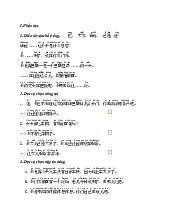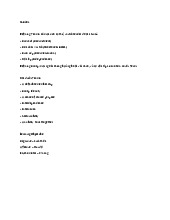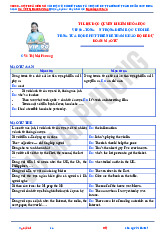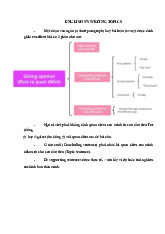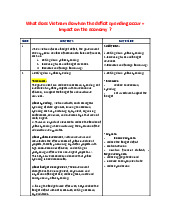





Preview text:
lOMoARcPSD|50582371
KỲ THI TỐT NGHIỆP TRUNG HỌC PHỔ THÔNG NĂM 2022 ĐỀ THI THAM
Bài thi: NGOẠI NGỮ, Môn thi: TIẾNG ANH KHẢO
Thời gian làm bài: 60 phút, không kể thời gian phát đề
Họ, tên thí sinh:………………………………….. Số báo danh:
……………………………….…….. ĐỀ SỐ 07
Mark the leWer A, B, C or D to indicate the correct answer to each of the following ques_ons.
Ques_on 1: Each element of the ceremony has a ___________ meaning. A. symbolize B. symbol C. symbolism D. symbolic
Ques_on 2: His parents are hospitable, ___________? A. do they B. don’t they C. are they D. aren’t they
Ques_on 3: I'm from a family of doctors, so I really ___________with tradiMon when I went to art school. A. went B. took C. contacted D. broke
Ques_on 4: He moved to London ___________ May 2019. A. in B. on C. at D. from
Ques_on 5: He uses his ___________ to write about his passion for science. A. chat room B. app C. blog D. data
Ques_on 6: The old man couldn’t read the magazine ___________ it was too dark there. A. despite B. because of C. because D. although
Ques_on 7: Tom wanted to buy this ___________ car 2 years ago.
A. white luxurious Japanese
B. Japanese luxurious white
C. white Japanese luxurious
D. luxurious white Japanese
Ques_on 8: Cheo singing has been ___________ for generaMons and the oral tradiMon is sMl very much alive today. A. taken aXer B. landed on C. passed down D. set off
Ques_on 9: Minh Huy ___________ his assignments when his parents came back home from work. A. was doing B. does C. is doing D. has done
Ques_on 10: ___________, the manager assistant wil inform us about the result.
A. When the meeMng had ended
B. When the meeMng ended
C. When the meeMng ends
D. When the meeMng was ending
Ques_on 11: Jack oXen ___________ simple mistakes in his reports. A. goes B. makes C. puts D. does
Ques_on 12: If parents are caught tel ing lie, they wil ___________ their children's respect. A. hold B. keep C. lose D. disappear
Ques_on 13: Our missions ___________ two days ago. A. finish B. were finished C. were finishing D. have finished
Ques_on 14: ___________all money supported by his family, some students started to do a part-Mme job to make ends meet. A. Have spent B. Having spent C. Have been spending D. Have been spent
Ques_on 15: The sooner we start the project, ___________result we may get. A. the best B. the be_er C. the more good D. the most good 1 lOMoARcPSD|50582371
Mark the leWer A, B, C or D to indicate the correct response to each of the following exchanges.
Ques_on 16: David and Helen are a_ending a birthday party together.
- David: “You’ve got a beauMful dress!” - Helen: “___________.” A. I do
B. Thanks for your compliment C. You too D. OK
Ques_on 17: Mary is talking to Tom about her job interview.
- Mary: “I’ve got an interview for a job tomorrow.” ____ Tom: “___________.” A. Thank you B. Same to you C. Good luck D. See you
Mark the leWer A, B, C, or D on your answer sheet to indicate the word that differs from the other three
in the posi_on of primary stress in each of the following ques_ons. Ques_on 18: A. sacrifice B. employment C. poliMcs D. energy Ques_on 19: A. finish B. listen C. reduce D. visit
Mark the leWer A, B, C, or D on your answer sheet to indicate the word whose underlined part differs
from the other three in pronuncia_on in each of the following ques_ons.
Ques_on 20: A. permi_ed B. wanted C. stopped D. needed Ques_on 21: A. park B. start C. card D. catch
Mark the leWer A, B, C, or D on your answer sheet to indicate the word(s) CLOSEST in meaning to the
underlined word(s) in each of the following ques_ons.
Ques_on 22: It has been raining so heavily for a long Mme. Wil it ever let up? A. brighten B. stop C. clear D. darken
Ques_on 23: Tourists flock to Phu Quoc to enjoy the holiday aXer a long Mme of social distancing.
A. come without arrangement
B. come in large numbers
C. com e out of boredom D. come by plane
Mark the leWer A, B, C or D on your answer sheet to indicate the word(s) OPPOSITE in meaning to the
underlined word(s) in each of the following ques_ons.
Ques_on 24: The Supreme Courts’ ruling should decide this ma_er once and for all. A. forever B. at once C. temporarily D. in the end
Ques_on 25: AXer months of fruitless negoMaMons with team owners, the city withdrew its offer to build a new stadium. A. profitable B. fuMle C. purposeful D. useless
Mark the leWer A, B, C, or Đ on your answer sheet to indicate the sentence that best combines each pair
of sentences in the following ques_ons
Ques_on 26: My relaMonship with my father is important. It has shaped my aktude towards men.
A. But for the important relaMonship with my father, it would have shaped my aktude towards men.
B. Only if my relaMonship with my father were important would it shape my aktude towards men.
C. So important is my relaMonship with my father that it has shaped my aktude towards men.
D. Not unMl my relaMonship with my father had shaped my aktude towards men was it important. 2 lOMoARcPSD|50582371
Ques_on 27: My beloved teacher has gone abroad, she can’t a_end my farewel party. A.
If only his beloved teacher had been at home and could have a_ended hisfarewel party. B.
He wishes his beloved teacher were at home and she could a_end his farewel party. C.
As long as his beloved teacher is at home, she can a_end his farewel party. D.
If his beloved teacher is at home, she can a_end his farewel party.
Mark the leWer A, B, c, or D on your answer sheet to indicate the underlined part that needs correc_on in
each of the following ques_ons.
Ques_on 28: Jane visits Trang An Scenic complex with her family last summer. A. visits B. Scenic C. her D. summer
Ques_on 29: I asked my kids to get off his phones and take part in some outdoor acMviMes. A. asked B. get off C. his D. take part in
Ques_on 30: Many large enterprises have established research and development centres to develop
technologies for the fourth industrious revoluMon.
A. large B. established C. to develop D. industrious
Mark the leWer A, B, C, or D on your answer sheet to indicate the sentence that is closes _n meaning to
each of the following ques_ons.
Ques_on 31: It is against the law to park on a double yel ow line. A. You are allowed
to park on a double yel ow line.
B. You must park on a double yel ow line.
C. You must not park on a double yel ow line.
D. You allow to park on a double yel ow line.
Ques_on 32: He said, “I have bought this car since last year.”
A. He said that he had bought this car since the previous year.
B. He said that he had bought that car since the previous year.
C. He said that he has bought this car since last year.
D. He said that he just bought that car since the previous year.
Ques_on 33: She started working for this company many years ago. A. She has worked
for this company since many years.
B. She worked for this company for many years.
C. She has worked for this company for many years.
D. She has started working for this company many years
Read the following passage and mark the leWer A, B, C, or D on your answer sheet to indicate the correct
word or phrase that best fits each of the numbered blanks from 34 to 38.
The life span of an elephant that dies from natural causes is about sixty-five years. Of course,
an elephant can perish from a number of “unnatural causes”; eg, it can be kil ed by hunters, most
probably for the valuable ivory in its tusks; it can die from diseases that spread throughout an
elephant herd; or it can die from drought or from the lack of food (34) ___________ almost certainly
accompanies the inadequate supply of water.
If, (35) ___________, an elephant survives these disasters, it falls grey to old age in its mid- sixMes.
Around this age, the (36) ___________of death is a_ributed to the loss of the final set of molars. When this
last set of teeth is gone, the elephant dies from malnutriMon because it is unable to obtain adequate (37)
___________. In old age, elephants tend to search out a final home where there is shade for comfort from 3 lOMoARcPSD|50582371
the sun and soX vegetaMon for cushioning; the bones of (38) ___________ old elephants have been found in such places.
(Adapted from Longman Complete course for the TOELF Test- Deborah Phillip)
Ques_on 34: A. who B. whose C. what D. that
Ques_on 35: A. therefore B. in addiMon C. however D. otherwise
Ques_on 36: A. reason B. cause C. factor D. effect
Ques_on 37: A. nourishment meal B. drink
C. refreshment D.
Ques_on 38: A. much B. many C. each D. every
Read the following passage and Mark the leWer A, B, C, or D on your answer sheet to indicate the correct
answer to each of the ques_ons from 39 to 43.
Big Bend NaMonal Park in the southwest of Texas is one of the most majesMc desert areas in the
United States. It is part of the Chihuahua, which is one of the largest deserts in North America and
stretches over both America and Mexico.
Big Bend Park is home to mountains, rivers, basins, valleys, as wel as many plants and animals. It is not
as popular of a naMonal park as some others. This may be because it takes an extremely long Mme to get
there. Big Bend NaMonal Park is hundreds of miles from the nearest legiMmate town or airport. When
people go there, they need to make sure that their cars have plenty of gas. There is a large risk of running out.
When visitors get to the park, they are usually happy that they drove all the way. The park is 1,252
square miles of desert beauty. There are beauMful cactus blooms as wel as glorious sunsets. The hiking
trails are magnificent. Visitors can stay in a lodge that is run by the park or camp with their own equipment.
However, visitors should be careful. Even though the park is incredibly hot during the day, the lack of
moisture in the air makes the heat dissipate at night. The nights at Big Bend are surprisingly cold. It’s
important to bring a warm sleeping bag.
(Adapted from Master TOEFL Junior Advanced- Reading Comprehension- Richie Hahn)
Ques_on 39: Which Mtle best summarizes the main idea of the passage?
A. A Place of Desert Flowers B. Cactus Bloom at Big Bend
C. A NaMonal Park to Be Visited
D. A Desert That Is Cold at Night
Ques_on 40: In paragraph 3, the word “lodge” is closest in meaning to___________. A. bed B. inn C. cavern D. restaurant
Ques_on 41: The word “they” in paragraph 3 refers to ___________.
A. cars B. people C. visitors D. miles
Ques_on 42: According to paragraph 2, which of the fol owing can be a reason to explain that Big Bend
Park isn’t as popular as some others? A. It is too cold for most visitors.
B. A lot of people don’t want to visit Texas.
C. Most cars aren’t strong enough to get there.
D. It is very far away from a town or an airport.
Ques_on 43: Which of the fol owing is NOT menMoned about staying overnight at Big Bend?
A. It’s be_er to stay in the lodge.
B. There are generally two different ways to sleep.
C. Visitors can bring their own camping equipment.
D. It’s too cold outside without a warm sleeping bag. 4 lOMoARcPSD|50582371
Read the passage and Mark the leWer A, B, C, or D on your answer sheet to indicate the correct answer to
each of the ques_ons front 44 to 50.
Climate change has already increased the risk of wildfire globally, according to a new review of research
that suggests the weather condiMons that led to the Australian wildfires wil become more common in future.
In light of the ongoing wildfire crisis in Australia, Richard Be_s at the UK Met Office in Exeter
and his col eagues reviewed 57 peer-reviewed studies about the link between climate change and wildfire
risk. All of them found that climate change increases the frequency or severity of fire- favourable weather
condiMons. The review found that fire weather seasons have lengthened
globally between 1979 and 2013. Fire weather generally involves hot temperatures, low humidity, low
rainfall in the preceding days and weeks, and windy condiMons.
Climate models also suggest that more extreme condiMons and longer fire seasons come as a result of
climate change, rather than fluctuaMons due to natural variaMon, the review reported.
The recent extreme weather in Australia - 2019 was both its ho_est and driest year on record – wil become
the “new normal” if the world conMnues a trajectory of warming close to 3°C, said Be_s at a press briefing
on Monday. Under Met Office model ing of 2°C of global warming, south-eastern
Australia is predicted to experience an extra 20 to 30 days per year of fire condiMons rated as “severe” or
worse on the McArthur Forest Fire Danger Index, said Be_s.
In severe fire condiMons, fires that start may become uncontrol able. In the worst condiMons, which have
been seen in Australia this wildfire season and are rated “catastrophic”, fires cannot
be control ed and pose a threat to life and property. LimiMng climate change to wel below 2°C in line
with the Paris climate deal is key to lowering future fire risks, the review concluded.
(Adapted from kites ://www. newscienJst. com/arJcle)
Ques_on 44: Which of the fol owing is the best Mtle for the passage? A. Wildfire crisis in Australia.
B. The risk of wildfire globally caused by climate change.
C. Wildfire crisis causes and effects.
D. How to control wildfire crisis globally.
Ques_on 45: According to paragraph 3, climate change leads to___________. A. low rainfall
B. longer fire seasons
C. lowering future fire risks
D. uncontrol able wildfires Ques_on 46: The word trajectory in
paragraph 3 IS closest in meaning to___________.
A. uncontrol able crisis B. threat C. property D. curved path
Ques_on 47: The word them in paragraph 2 refers to___________.
A. peer -reviewed Studies B. wildfire crises
C. climate change and wildfire risk D. col eagues
Ques_on 48: The word “catastrophic” in paragraph 4 is Closest in meaning to ___________. A. control able B. severe C. disastrous D. extreme
Ques_on 49: Which of the fol owing is NOT true according to the passage?
A. There will be more wildfires in Australia caused by severe weather condiMon.
B. Hot temperatures, low humidity, low rainfall are signs of fire weather.
C. Severe forest fires are oXen uncontrol able.
D. Forests fires in south-eastern Australia oXen lasts 20 to 30 days per year. 5 lOMoARcPSD|50582371
Ques_on 50: Which of the fol owing can be inferred from the passage? A. Forest fires in
Australia are more severe than other places.
B. There’s a close relaMonship between climate change and wildfires.
C. Wildfires are more and more uncontrol able.
D. Richard Be_s has done a research about wildfires all over the world. 6
